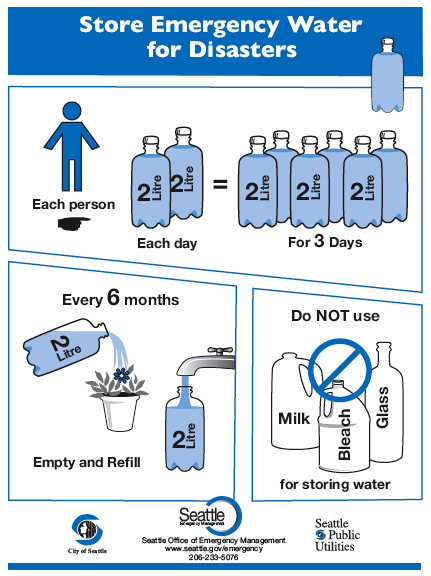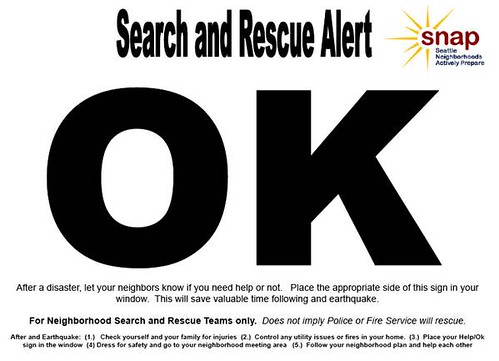One take away from this New York Times opinion piece on Seattle’s mega-quake vulnerability — we’re screwed:
We engineers and seismologists need to gather and study as much data as we can from Chile’s quake. But one thing is already clear: based on the kind of damage that buildings suffered in Chile, tall structures in the earthquake zones of the United States appear to be at much higher risk than we thought. This lesson should be of obvious concern to San Francisco and Los Angeles. But it is actually the Pacific Northwest that is most vulnerable to a mega-quake like Chile’s.
Just off Northern California, Oregon, Washington and British Columbia sits the 600-mile-long Cascadia fault. Like the Nazca tectonic plate that caused the quake and tsunami in Chile, Cascadia can produce temblors with magnitudes of 9 or greater, more powerful than anything we’ve experienced or expect from California’s famous San Andreas fault.
Cascadia’s last mega-quake, in January 1700, was approximately as large as Chile’s; it caused a tsunami that pummeled Japan. Many seismologists believe the Pacific Northwest is overdue for another mega-quake. Yet in cities like Seattle, Vancouver and Portland, Ore., hardly any building is designed to withstand such a huge jolt.
 Another: It’s time to check out a group like Capitol Hill Preparedness People or at least learn from them about how to take care of yourself and your loved ones. CHS wrote about CHPP here and featured this recent video made by the City of Seattle about the group. We also featured this roster of PDFs from the Seattle Office of Emergency Management with info about assembling preparedness kits and more.
Another: It’s time to check out a group like Capitol Hill Preparedness People or at least learn from them about how to take care of yourself and your loved ones. CHS wrote about CHPP here and featured this recent video made by the City of Seattle about the group. We also featured this roster of PDFs from the Seattle Office of Emergency Management with info about assembling preparedness kits and more.
We can also learn from each other. A lot of people tune into CHS after they feel a temblor so we’ll be one source of info about the neighborhood but you might also think about getting to know how Twitter and Facebook work if you haven’t already. Those kinds of social tools might be the only source of information functioning after a big quake.
Of course if electrical, Internet and mobile services are disrupted, social media won’t be much help either. That’s when smart things you’ve done now will help — like make an order of some extra canned goods, water and a new medical kit for your home. Any more Capitol Hill survivalist advice? Comments, please.





Like many, I live in an old brick studio. Chances are it is very vulnerable to falling in an earthquake. Maybe I will survive. But the fact is it is not realistic to expect folks like me to store much stuff in preparation. THere is no space (or money) for much. I am old and remember in the buclear hysteria in the 50’s and 60″s there were stockpiles of food and water in most public buildings. I think that is the strategy that needs to be developed.
There are many things that are wrong in this article.
1) Chile’s cities are much closer to their fault than we are to the Cascadia subduction zone (on average) not to mention the difference in soil conditions which may or may not amplify motions.
2) At such a high magnitude (ie. The mega quake) the goal is not to have a building that is usable, the goal is to preserve life. A building damaged beyond repair does not necessarily mean it performed poorly.
3) A building under construction is not at it’s full design strength or at the fundamental period of which it was designed for.
4) To say a building is half under designed because EQ’s occur half as often is just wrong. That is not how the probability works.
5) Thicker, stiffer structures are not necessarily better. They attract more load than flexible structures. It also changes the fundamental period of a building which determines whether or not buildings will resonate while shaking.
6) As is always the case with probability there will be some percentage of failures.
The cost to society to design everything for any possible natural disaster is too much for society to afford. There is no such thing as zero risk in life. You only hope to limit damage within your means and survive.
But this shouldn’t take away from people understanding that natural disasters are possible (and likely given enough passage of time) and that there is a probability that the outcome will not be as planned. So plan the best you can.
Not to mention… The op-ed author “runs a structural engineering and earthquake consulting firm.” His consulting business certainly stands to gain from increased fear/uncertainty. Not a huge conflict in the scheme of things, as he’s also certainly an expert, but still I’m surprised the NYTimes published this piece.
As for the Seattle Public Utilities graphic on this CHS article, are we a British colony?
The city of seattle put together a pretty good study on natural disasters in the area.
http://www.seattle.gov/emergency/library/SHIVA.pdf
The second CHS link in the second paragraph is off. should be: http://capitolhillseattle.com/2010/03/26/capitol-hill-prepar
Thanks. Fixed
If you have room in your freezer, you could store water by filling freezer bags with ice cubes. Obviously, if the power goes out in an emergency this will be the water you drink first after moving the ice into more liquid-friendly containers.
I’m a big fan of the NYT, but their proclamations about Seattle’s readiness were widely criticized. To clear up that issue and many others, we invited a group of LOCAL experts to answer questions on http://www.questionland.com. They’ll be there from April 26-30 answering questions online.
Robin Friedman, Director King County Emergency Management, Paul Bodin, UW Seismologist & Bruce Schoonmaker, Earthquake Prepared